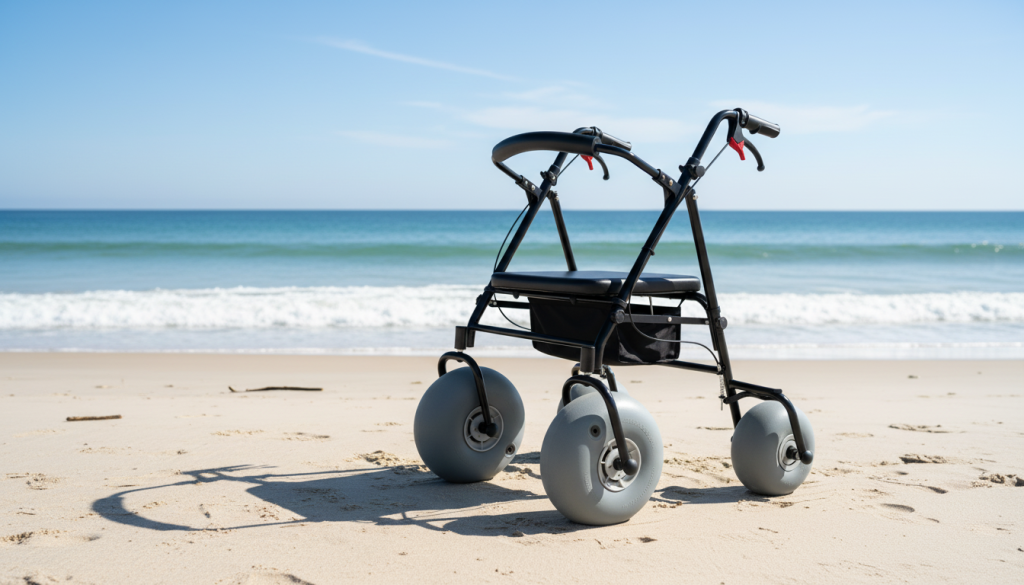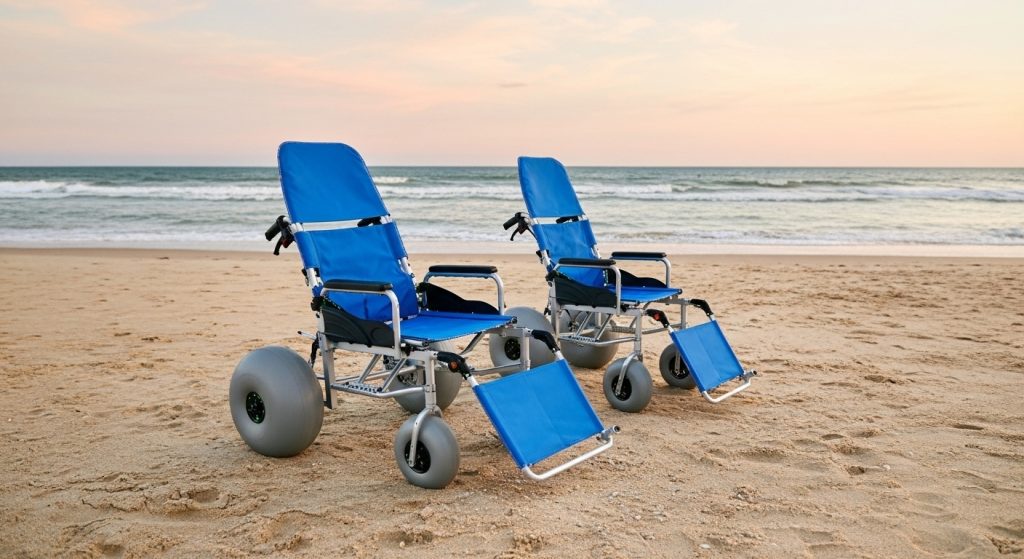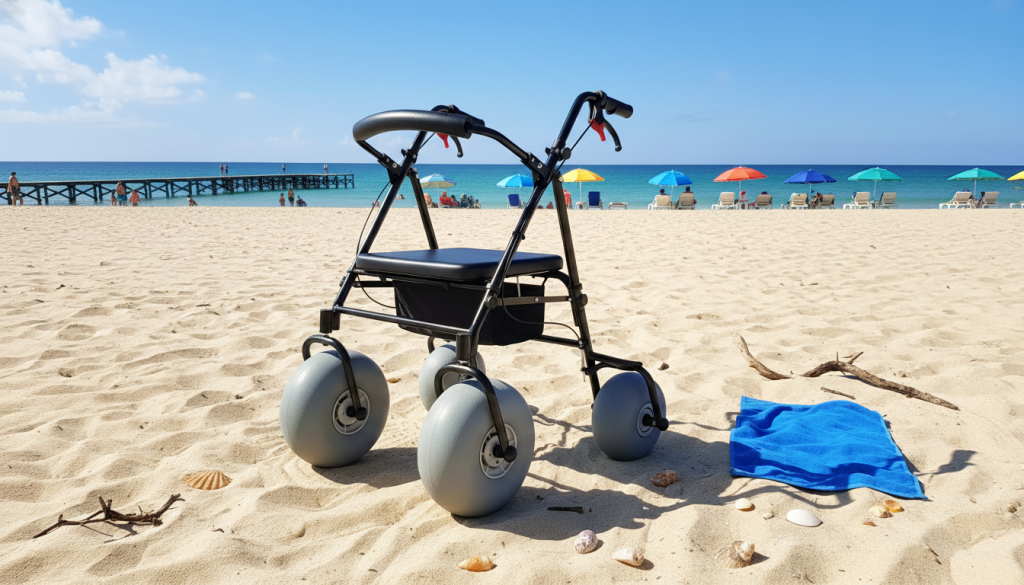The ocean’s timeless rhythm calls to us—a hypnotic whisper of crashing waves and the scent of salt on the breeze. For many, the desire to feel the shifting grains underfoot is a primal, cherished dream. But that dream can quickly sour. Bring an ordinary mobility walker to the shore, and you’ll instantly discover the syrupy drag of wheels burying themselves, turning a leisurely stroll into an exhausting battle. It’s a frustrating fight against physics, a struggle that can make the waterline feel miles away.
But what if the right equipment could transform this ordeal into serene stability? What if you could glide over the sand instead of fighting it? The corrosive kiss of salt and grit doesn’t have to mean defeat. This guide is your map to reclaiming the shoreline. It’s the difference between watching the waves from a distance and finally feeling them lap at your ankles again. Before you buy, let’s ensure your choice empowers your freedomwith the right beach walker not hinders it.
The Sinking Feeling: Why Your Everyday Walker Just Won’t Work on the Beach
If you’ve ever tried to push a stroller with thin wheels through soft sand, you already know the problem. The same principle applies to standard mobility walkers. They are designed for smooth, hard surfaces like pavement and indoor flooring, not the beautiful but challenging environment of a sandy beach. Trying to force the issue isn’t just tiring; it can be unsafe and damaging to your equipment.
Sand vs. Skinny Wheels: A Recipe for Frustration
The fundamental flaw of a regular walker on the beach lies in its wheels. They are typically narrow and hard, designed to have a small contact patch with the ground to minimize rolling resistance on firm surfaces. On soft sand, this design is a disaster. The narrow wheels act like knives, slicing into the sand instead of rolling over it. All your forward momentum is lost as the wheels dig in and get stuck, turning a simple walk into a high-effort, low-reward workout.
This isn’t just a matter of convenience; it’s a major barrier to beach accessibility. For elderly individuals and those with limited mobility, this can create a dangerous situation, risking a loss of balance and a potential fall on uneven ground. The goal is outdoor freedom, not a battle with your own mobility aid. A walker that sinks is a walker that fails to provide the stable support you need most. You need a true sand-friendly walker, not a glorified anchor.

The Hidden Dangers: Why Salt, Sand, and Sun Are Your Walker’s Worst Enemies
Even if you could somehow muscle your way across the sand, the coastal environment wages a silent war on your equipment.
- Corrosion: Salt is incredibly corrosive. The salty air and mist, let alone a splash from a wave, will attack standard steel frames and components. Bolts, screws, and brake mechanisms will begin to rust, compromising the walker’s structural integrity and safety. What was once a sturdy frame can become a fragile liability.
- Abrasion: Sand is essentially a collection of tiny, abrasive rocks. These fine particles get into every nook and cranny, especially wheel bearings, brake cables, and folding mechanisms. This grit grinds away at moving parts, causing them to seize up, wear out prematurely, and fail when you need them.
- UV Degradation: The sun’s powerful UV rays can degrade plastic components, rubber handgrips, and seats over time, making them brittle and prone to cracking.
An everyday walker is simply not built to withstand this three-pronged attack. To enjoy coastal adventures safely and for years to come, you need a mobility aid for sand built with waterproof materials and corrosion-resistant materials from the ground up.
Decoding the Perfect Beach Walker: The 5 Must-Have Features
So, what transforms a standard rollator into a go-anywhere all-terrain walker? The secret lies in a few key design choices engineered specifically for rough terrain. When shopping for your perfect beach rollator, these are the non-negotiable features that separate the beach-ready from the beach-bound.
It’s All About the Wheels: Why Bigger and Wider is Better
This is the single most important feature. To conquer sand, you need wheels that float, not sink.
| Wheel Type | Description | Best For |
|---|---|---|
| Balloon Wheels | These are the undisputed champions of sand mobility. Oversized balloon-style wheels (like the famous WheelEEZ Wheels) are wide, soft, and use very low-pressure tires. This distributes your weight over a much larger surface area, allowing the walker to roll effortlessly over soft sand, mud, and other challenging terrains. They provide the smoothest ride and the best flotation. | Deep, soft sand; maximum ease of use on the beach. |
| Pneumatic Tires | Essentially large, air-filled tires similar to those on a bicycle, these are a fantastic feature for an outdoor rollator. They offer excellent shock absorption, which is a blessing not just on sand but also on gravel, grass, and cobblestone paths. The larger diameter of these big wheels (often 10-12 inches) helps them roll over obstacles instead of getting stuck in them. | Mixed outdoor use, including beaches, parks, and trails. They provide a comfortable, cushioned ride and great traction. |
| Wide Polyurethane Wheels | These are solid, puncture-proof wheels made from durable polyurethane. While they don’t offer the same level of cushioning as inflatable tires, the key is their width. A wide wheel rollator with solid, wide-profile wheels offers a significant improvement over standard skinny wheels. They provide better traction and are less likely to sink into moderately packed sand. | Users who want a maintenance-free, puncture-proof option that still performs well on various uneven surfaces, including firm sand and boardwalks. |
Ultimately, whether you choose low-pressure balloon wheels or a large wheel walker with pneumatic tires, the goal is the same: to prevent sinking and provide a smooth ride on sand.
Frame Game Strong: Choosing Materials That Laugh in the Face of Rust
As we discussed, salt is the enemy. A true beach walker must be built from materials that can stand up to the harsh coastal environment.
- Marine-Grade Aluminum: This is the most common material for a high-quality sand-friendly walker. It’s naturally rust-resistant and offers an excellent balance of strength and lightweight construction. Look for models with an anodized aluminum frame or a powder-coated finish for an extra layer of protection.
- Stainless Steel: For components that see the most stress and exposure—like axles, casters, and fasteners—marine-grade stainless steel (ideally
316L Stainless Steel) is the gold standard. It offers superior corrosion resistance and ensures the walker’s joints and moving parts remain reliable.
- Durable PVC: Some specialized beach walkers and beach wheelchair alternatives are constructed from high-grade PVC. This material is completely impervious to rust and corrosion, making it a very practical, albeit sometimes less rigid, choice for coastal use.
Investing in a walker with these salt-resistant materials means you are investing in longevity and safety. With a quick rinse of fresh water after each trip, a well-made rust-proof walker will provide years of reliable service.
Brakes You Can Trust: How to Stay Secure on Shifting Sands
You wouldn’t drive a car without reliable brakes, and the same logic applies to your walker. On shifting sand, slight inclines, or slippery, wet beach access ramps, a secure braking system is essential for your safety and stability.
Look for a user-friendly braking system, such as loop-lock hand brakes, which are easy to engage. These brakes should allow you to:
- Squeeze to slow down, giving you control on slopes.
- Push down to lock, securely parking the walker when you want to stop, stand still, or use the built-in seat.
On a beach rollator, it’s also important that the brake mechanisms are either sealed or designed to be easily cleaned. This prevents sand and salt from jamming the cables and compromising your ability to stop safely. A reliable dual brake system is a cornerstone of confidence when navigating uneven terrain.
Fold, Lift, and Go: The Importance of Weight and Portability
Your beach adventure doesn’t start at the waterline; it starts at your car. How easily can you get your walker from the trunk to the sand? This is where portability becomes a key factor.
Look for a folding frame that is easy to operate, ideally with a tool-free folding mechanism. A collapsible mobility device should fold down into a manageable size that fits in your vehicle and is easy to store at home. This is a crucial feature of any good travel-friendly design.
Weight is the other half of the equation. While a durable frame is essential for stability, a lightweight aluminum frame can make a world of difference when lifting the walker in and out of a car. Pay attention to the product’s listed weight and consider what you can comfortably handle. The goal is independent mobility, and that includes being able to manage your own equipment.

Comfort is King: Features You’ll Be Grateful For After a Day in the Sun
Beyond the core mechanics of navigating sand, certain features can elevate your seaside experience from functional to truly enjoyable. A great all-terrain rollator is not just about mobility; it’s also about comfort and convenience, allowing you to relax and soak in the scenery.
Take a Seat! Why a Built-in Bench is a Beach Day Game-Changer
A walk on the beach, even with the best equipment, can be tiring. Having a padded seat integrated into your walker is an absolute game-changer. It provides a convenient place to rest whenever you need a break, without having to search for a bench or struggle to get down onto a towel.
This feature transforms your walker from a simple mobility aid into your personal, portable beach chair. You can stop to watch the waves, chat with a friend, or simply catch your breath. For seniors or anyone managing their energy levels, having a comfortable and stable place to sit provides peace of mind and makes a longer outing possible. Look for a seat at a comfortable height that allows you to sit and stand with minimal effort.
Got Your Back: Don’t Underestimate a Good Backrest
If your walker has a seat, a supportive backrest is the perfect companion. A simple strap or a more structured, padded seat and backrest provides crucial ergonomic support, improving your posture and comfort while seated. It prevents you from having to slouch or balance, allowing you to truly relax. This small feature makes a huge difference in turning a short rest into a genuinely comfortable break, reducing strain on your back and promoting better mental well-being.
Stow Your Stuff: The Magic of Onboard Storage for Towels and Sunscreen
Where are you going to put your towel, sunscreen, book, water bottle, and sunglasses? Juggling a bag while operating a walker is cumbersome and unsafe. A built-in storage compartment is the solution.
Most outdoor rollators come with a storage bag or basket, typically located under the seat. This storage pouch keeps your hands free and your belongings secure. You can easily pack all your senior beach equipment and accessories for the day without needing to carry a separate bag. It’s a simple feature that dramatically improves convenience and safety, letting you focus on your walk and the beautiful view.
Your Smart Shopper’s Checklist: Questions to Ask Before You Add to Cart
You’re now armed with the knowledge of what makes a great beach walker. Before you make a final decision, run through this checklist to ensure you’re making the smartest investment for your needs and your outdoor adventures.
Finding Your Perfect Fit: How to Measure for Height and Comfort
A walker that doesn’t fit properly can cause back, shoulder, and wrist pain. To ensure a perfect fit:
- Adjustable Handle Height: Stand inside the walker with your arms hanging loosely at your sides. The handgrips should be at the height of your wrist crease. This ensures you can maintain a slight bend in your elbows and walk with an upright position for proper posture and support.
- Seat Height: If you’re opting for a model with a seat, check its height. When seated, your feet should be flat on the floor with your knees at a 90-degree angle. This provides the most stable base for sitting down and standing up.
- Weight Capacity: Always check the manufacturer’s specified weight capacity. Ensure it can safely support your weight, plus the weight of anything you might carry in the storage bag. It’s always better to have a higher capacity than you think you need.
New, Used, or Rented? Exploring Your Options and Budget
A high-quality all-terrain beach walker can be a significant investment. Thankfully, you have options.
- Buying New: This gives you the latest technology, a full warranty, and the peace of mind that all components are in perfect condition. It’s the best option for long-term, frequent use.
- Buying Used: You may find a good deal on a used model online or through local mobility suppliers. If you go this route, inspect the walker carefully. Check the frame for any signs of damage or corrosion, test the brakes thoroughly, and examine the wheels for wear and tear.
- Renting: If you only need a beach walker for a short vacation or want to try a model before you buy, beach equipment rental services are a fantastic option. Many coastal towns have businesses that rent out beach wheelchairs, sand-friendly walkers, and other adaptive equipment for beaches. This is a cost-effective way to ensure you have the right gear for your trip.
You’ve Got Your Walker! Now, Here’s How to Have the Best Beach Day Ever
Congratulations! You’ve chosen the perfect mobility solution for beach days. Now, let’s make sure you have the best, safest, and most enjoyable experience possible. A little planning and a simple post-trip routine can make all the difference.
The Path of Least Resistance: How to Plan Your Journey to the Waterline
Even with the best off-road rollator, a little strategy goes a long way.
- Look for Accessible Beaches: Many public beaches are now making significant strides in beach accessibility. Before you go, do a quick search for beaches in your area that offer accessible beach facilities.
- Find the Mats: The gold standard for beach access is the beach access mat. These portable, roll-out walkways (like Mobi-Mats) create a firm, stable surface over the sand, providing a direct accessible path across the sand for walkers, strollers, and wheelchairs.
- Use Ramps and Boardwalks: Take advantage of any accessible boardwalks or beach access ramps. These structures are designed to get you over the deepest, softest sand near the dunes, saving you energy for your walk by the water.
- Check for Accessible Parking: Parks with handicap beach access often have designated accessible parking at beaches located closer to the access points, minimizing the distance you have to travel before you hit the sand.
A Quick Clean-Up: The 5-Minute Post-Beach Care Routine for Your Walker
Your corrosion-resistant walker is tough, but a little TLC will dramatically extend its life and ensure its safe operation.
- Rinse Thoroughly: As soon as you get home, give your walker a good rinse with fresh water from a hose. Pay special attention to the wheels, brakes, and any folding joints to wash away all salt and sand.
- Wipe Down: Use an old towel to wipe the walker dry. This prevents water spots and ensures moisture doesn’t sit in crevices.
- Check Brakes: Squeeze the hand brakes and engage the locks to make sure they are moving freely and are not gritty with sand.
- Inspect Wheels: Give the wheels a spin to ensure they rotate smoothly. Remove any tangled seaweed or debris.
- Store Properly: Store your clean, dry walker in a protected area like a garage or shed, ready for your next adventure.
This simple routine takes only a few minutes but is the most important thing you can do to protect your investment and guarantee your walker is safe and ready for your next trip.

Don’t Just Dream of the Beach—Go There
The call of the ocean is for everyone. For too long, the simple pleasure of a walk on the beach has felt out of reach for many who rely on mobility aids. But with the right equipment, that barrier is dissolving. A purpose-built beach walker with large wheel design, corrosion-resistant materials, and comfortable, safe features is more than just a piece of equipment—it’s a key to unlocking outdoor freedom and independence.
It’s the tool that allows you to make new memories, to feel the sun on your face and the breeze in your hair, and to once again hear the waves crash at your feet. So do your research, choose the walker that’s right for you, and get back to the beach. The sand is waiting.
Recommended Products You May Like
- Beach Walker – All-Terrain Sand Mobility
https://www.arymd.com/beach-walker/ - Floating Beach Wheelchair
https://www.arymd.com/ - All-Terrain Outdoor Mobility Series
https://www.arymd.com/ - Beach Accessibility Equipment Collection
https://www.arymd.com/ - Request for Bulk Purchase / Dealership
https://www.arymd.com/contact/
